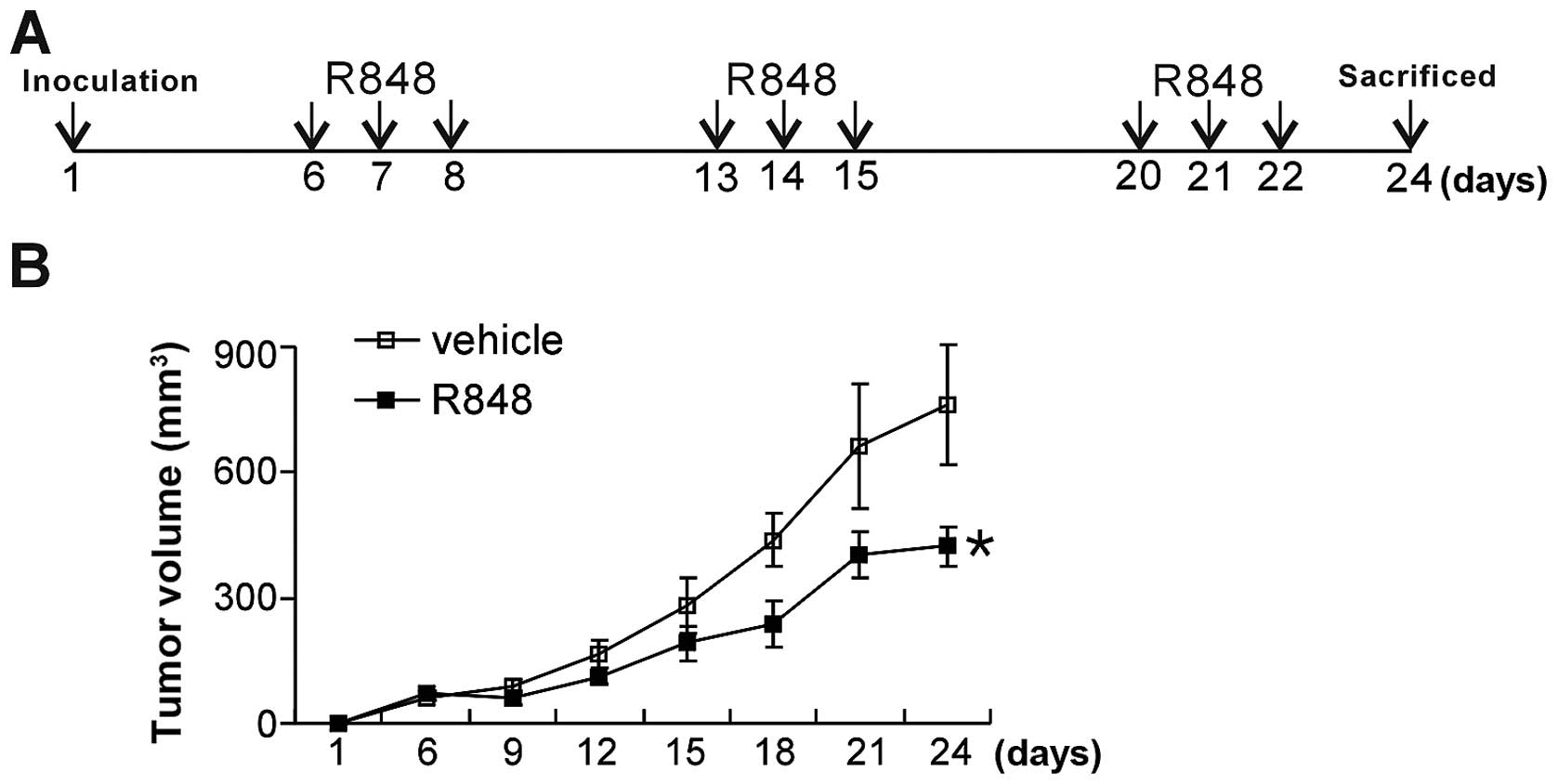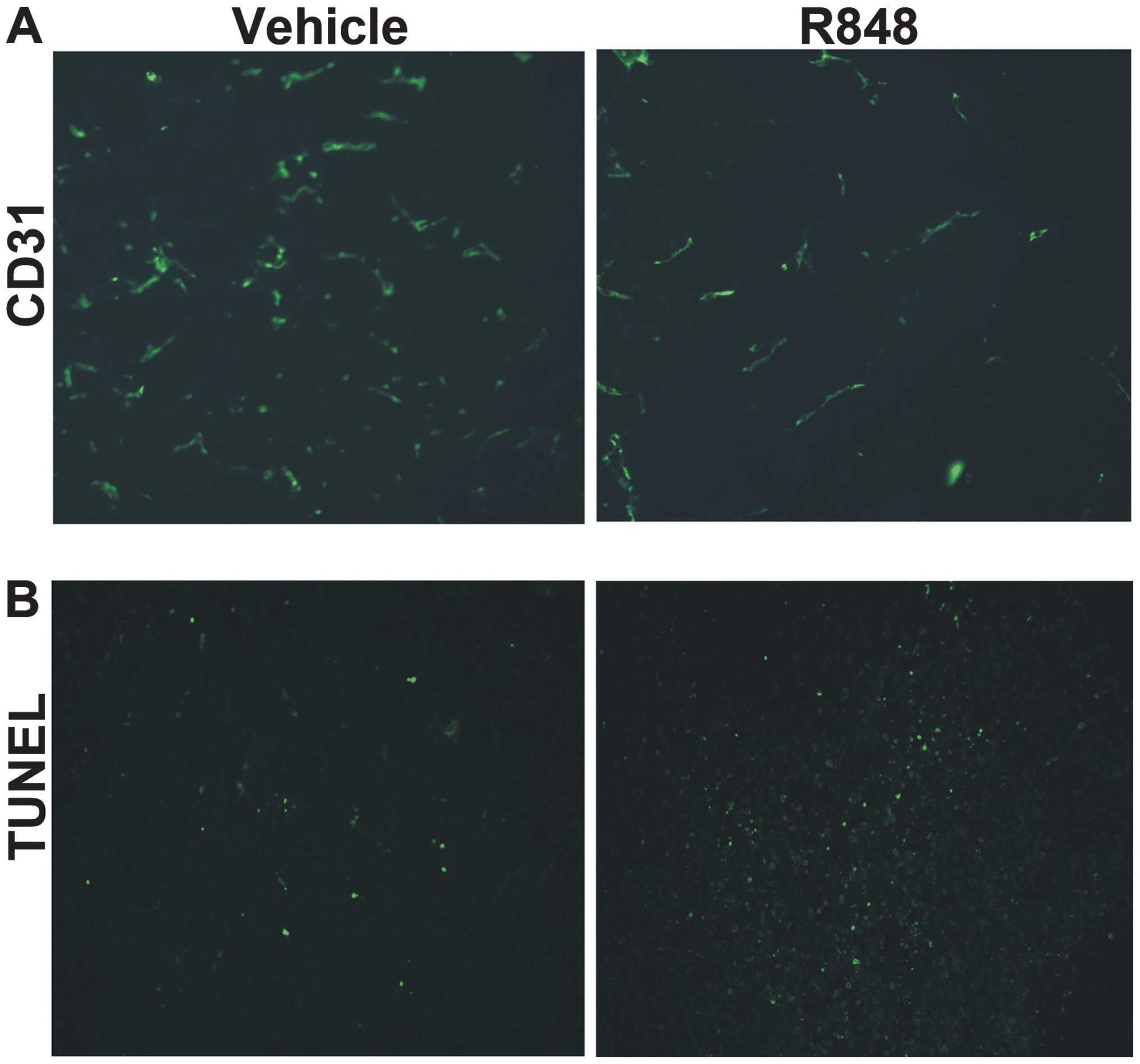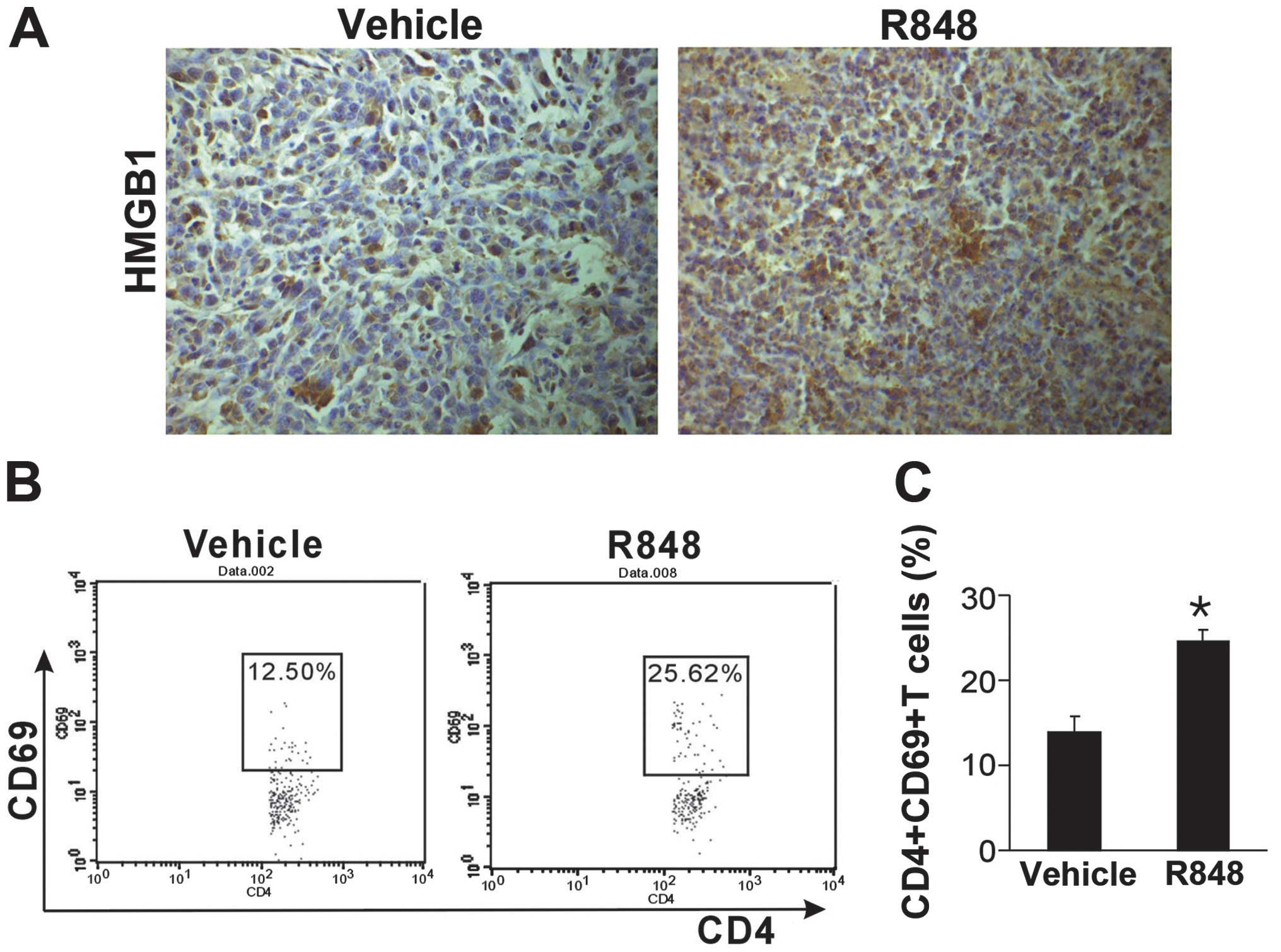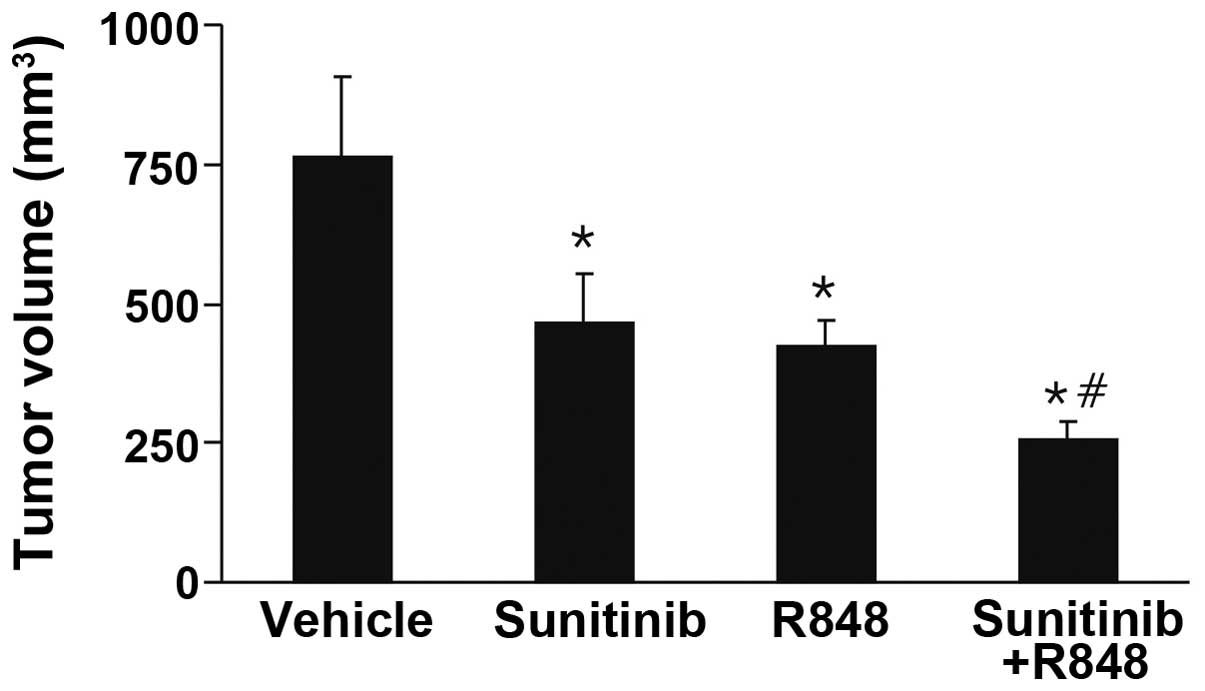Toll‑like receptor 7/8 agonist, R848, exhibits antitumoral effects in a breast cancer model
- Authors:
- Published online on: June 3, 2015 https://doi.org/10.3892/mmr.2015.3885
- Pages: 3515-3520
Abstract
Introduction
Toll-like receptors (TLRs) are pattern recognition receptors, which bind with pathogen-associated molecular patterns, such as lipopolysaccharide (LPS), and damage-associated molecular patterns (DAMPs), including S100A, high mobility group box 1 (HMGB1) and heat shock protein, which are released from necrotic and apoptotic cells (1). TLR signaling initiates divergent pathways, which exert either a protumor response or an antitumor response (2). Activation of TLRs expressed on tumor cell surfaces promotes tumor cell survival (3). TLR4 contributes to the immune response to anticancer chemotherapy and radiotherapy (4). A recent study revealed that the TLR4/NANOG oncogenic signaling pathway conferred cancer stem cell chemoresistance in Hepatitis C virus (HCV)-associated hepatocellular carcinoma (HCC) (5). Paradoxically, TLR agonists have also been demonstrated to have potent anticancer effects. The TLR2/4 agonist, Bacillus Calmette-Guérin has been used successfully for bladder cancer treatment (6). The TLR3 agonists Ampligen and polyuridilyc acid have also been developed for cancer treatment (7,8). In addition, the TLR7/8 agonist imiquimod has received Food and Drug Administration approval for the topical treatment of various dermatological malignancies (9). However, to the best of our knowledge, the systemic use of TLR7/8 agonists has not been investigated in a breast cancer model.
Angiogenesis is essential for tumor growth and progression, therefore targeting angiogenesis is a promising strategy for cancer therapy (10). However, a number of studies have suggested that anti-angiogenic therapy may induce immunosuppression and cancer stem cell enrichment (11–13). Anti-angiogenic therapy with vascular endothelial growth factor antibody and sunitinib may recruit myeloid-derived suppressor cells (MDSCs) in tumor-bearing mice (11,14), which may promote tumor angiogenesis through matrix metallopeptidase 9 secretion and direct differentiation into endothelial cells (15); however, eventually, resistance is developed to anti-angiogenic therapy. Sunitinib is an anti-angiogenesis agent and in the present study it was used in combination with the TLR7/8 agonist to determine whether it increases the efficacy of anti-angiogenesis therapies.
In the present study, the antitumoral effect of TLR7/8 was investigated in a murine breast cancer model. The synergistic antitumor effect of the TLR7/8 agonist, R848, plus sunitinib was also assessed. The present study aimed to investigate the potential use of a TLR7/8 agonist in cancer therapy.
Materials and methods
Cell culture and reagents
Murine 4T1 breast cancer cells were maintained in RPMI-1640 (Gibco-BRL, Gaithersburg, MD, USA) supplemented with 10% fetal bovine serum (Gibco Life Technologies, Grand Island, NY, USA) and amikacin (100 µg/ml; Henan Topfond Pharmaceutical Co., Ltd., Henan, China) in a humidified atmosphere containing 5% CO2 at 37°C. R848 was purchased from Sigma-Aldrich (St. Louis, MO, USA) and sunitinib was purchased from Pfizer (New York, NY, USA).
Tumor challenge and therapeutics
The study was approved by the Ethics Committee of Sichuan University (Chengdu, China). BALB/c mice were purchased from Beijing HFK Bioscience (Beijing, China), and were conditioned under a specific pathogen free environment in the State Key Laboratory of Biotherapy (Chengdu, China). Female BALB/c mice (age, 6–8 weeks) were inoculated subcutaneously with 1×106 4T1 cells. At day 6 after inoculation, mice were treated with vehicle (6% dimethyl sulfoxide + 94% normal saline) and R848 [3 mg/kg, intraperitoneally (IP)] (n=5/group). For combination therapy, tumor bearing mice were also treated with sunitinib [10 mg/kg, per os (P.O.)], or sunitinib (10 mg/kg, P.O.) plus R848 (3 mg/kg, IP) (n=5/group). The delivery strategy for R848 is described in Fig. 1A. Briefly, R848 was injected IP for three continuous days in a week for three weeks. Sunitinib was gavaged daily for 16 days. Tumor diameters were measured with a vennor caliper (Shanghai Taihai Measuring Tools Co., Ltd., Shanghai, China) and tumor volumes were calculated by the formula: 0.52 × a × b2, where a is the larger diameter and b is the smaller diameter of the tumor mass. Twenty-four days after inoculation, mice were sacrificed by cervical dislocation.
Flow cytometry
At day 24 after tumor inoculation, blood from tumor-bearing mice was collected. Red blood cells were lysed and then mononuclear cells were stained using CD4-PerCP-Cy5.5 (rat anti-mouse; monoclonal; 553052) and CD69-PE (armenian hamster anti-mouse; monoclonal; 553237) antibodies (BD Pharmingen, San Diego, CA, USA). For flow cytometric analysis, cells were acquired using a FACSCalibur (342973) flow cytometer and then analyzed with CellQuest software, version 6.0 (BD Biosciences, Mountain View, CA, USA).
Immunohistochemistry and immunofluorescence
Tumor tissues were paraffin-embedded and sectioned. Tumor sections were stained with an antibody against HMGB1 (rabbit monoclonal; ab79823; Abcam, Cambridge, UK), followed by biotin-conjugated secondary antibody and streptavidin-horseradish peroxidase complex. 3,3′-diaminobenzidine was used as the enzyme substrate. For tumor vasculature assessment, frozen tumor sections were stained with CD31-flurorescein isothiocyanate antibody (rat monoclonal; 102405; BioLegend, San Diego, CA, USA). Images were captured for each tumor by using a Leica DM2500 microscope (Leica Microsystems GmbH, Wetzlar, Germany).
Terminal deoxynucleotidyl transferase-mediated dUTP nick end labeling (TUNEL) assay
For apoptotic assessment, paraffin tumor sections were subject to a TUNEL assay (Promega, Madison, WI, USA), according to the manufacturer's instructions. Briefly, tumor samples were deparaffinized and fixed with 4% methanol-free paraformaldehyde for 10 min at room temperature. The samples were washed with phosphate-buffered saline (PBS) twice for 5 min and then permeabilized with 20 µg/ml proteinase K solution at room temperature. Tissue sections were then fixed with 4% methanol-free formaldehyde solution for another 5 min at room temperature. The samples were washed with PBS and incubated with equilibration buffer for 10 min at room temperature, then the equilibration buffer was removed and reaction buffer containing terminal deoxynucleotidyl trans-ferase enzyme, nucleotide mix and equilibration buffer was added to the sections. The slides were incubated at 37°C for 60 min inside the humidified chamber. Slides were protected from direct light. The reaction was terminated by immersing the samples in 2X saline-sodium citrate for 15 min at room temperature. Samples were then washed thoroughly to remove unincorporated fluorescein-dUTP. Immunofluorescence microscopy was performed on a fluorescence microscope (Leica DM2500).
Statistical analysis
All data are expressed as the mean ± standard deviation. Statistical comparisons between two groups were measured with Student's t-test. Statistical comparisons among four groups were measured using a one-way analysis of variance. P<0.05 was considered to indicate a statistically significant difference.
Results
TLR7/8 agonist exhibits antitumoral effects
To assess the antitumoral effect of a TLR7/8 agonist, tumor-bearing mice were treated with R848 (3 mg/kg). The delivery strategy of R848 is described in Fig. 1A. R848 significantly retarded tumor growth compared with the vehicle group (Fig. 1B), suggesting that TLR7/8 agonist R848 has a robust antitumoral effect in the breast cancer model.
TLR7/8 agonist reduces tumor vasculature and induces apoptosis
In order to observe the vasculature in the tumor microenvironment, tumor sections were stained for CD31 expression. Tumor vessel density was markedly decreased in the R848-treated group, while tumors in the control group exhibited clear CD31 staining (Fig. 2A). A TUNEL assay was performed to detect apoptosis following treatment. Compared with the control group, there was a greater increase in tumor cell death in the mice treated with R848 (Fig. 2B). The present data suggests that TLR7/8 agonist therapy may reduce the density of tumor vasculature and induce tumor cell apoptosis.
TLR7/8 agonist upregulates HMGB1 and activates CD4+ T cells
HMGB1 has been observed to be an endogenous danger signal to alert the immune system. To investigate whether HMGB1 is involved in the antitumoral effect of R848, tumor sections were stained with an antibody against HMGB1. Compared with the control group, TLR7/8 activation with R848 exhibited higher HMGB1 expression (Fig. 3A). It was subsequently determined whether CD4+ T cells were activated following R848 treatment. CD4+CD69+ T cells in the blood were evaluated using flow cytometry. It was identified that there was an increased quantity of activated CD4+CD69+ T cells in the peripheral blood following R848 therapy (Fig. 3B). The present results suggest that TLR7/8 activation induces HMGB1 release and activates T cells.
Synergistic antitumoral effects of R848 and sunitinib
A recent study demonstrated that a systemic TLR7/8 agonist may enhance the effect of radiotherapy (16). To determine whether a systemic TLR7/8 agonist enhanced the antitumoral effect of anti-angiogenic therapy, 4T1 tumor-bearing mice were treated with R848 and sunitinib. As expected, a synergistic effect between R848 and sunitinib was observed. The combinational treatment robustly retarded tumor growth, compared with vehicle and monotherapy groups (Fig. 4). These data suggested that systemic delivery of sunitinib and R848 has a synergistic antitumoral effect.
Discussion
TLRs have been observed to be expressed on the tumor surface (3). DAMP activation of TLRs expressed on tumor cell surfaces initiates numerous signaling cascades, which mediate angiogenesis and tumor survival and progression (17). The pluripotency marker NANOG was recently found to be the direct target of TLR4. The activated TLR4/NANOG oncogenic signaling pathway is associated with tumor stem cell chemoresistance in HCV-associated HCC (5). In addition, by inducing immunosuppressive cytokines, TLR4 signaling also promotes immune escape of cancer cells (18). Paradoxically, TLR agonists may also exert marked antitumoral effects. Several approaches employ TLR activation in immune responses to enhance tumor surveillance and cytotoxicity (2). In the present study, it was identified that TLR7/8 activation with R848 may retard tumor growth and induce increased levels of tumor cell apoptosis. Recent studies have demonstrated that the topical TLR7 agonist imiquimod can induce therapeutic effects in breast cancer metastasis to the skin (19). In addition, TLR agonists have been demonstrated to have adjuvant effects in cancer therapy. Topical imiquimod had been observed to inhibit tumor growth and act synergistically with radiotherapy in a mouse model of cutaneous breast cancer (20). Systemic administration of the TLR7/8 agonist R848 in combination with radiation was demonstrated to enhance antitumoral immune responses in lymphoma-bearing mice (16). The present study revealed that the systemic administration of the TLR7/8 agonist R848 was effective for the treatment of a murine model of breast cancer, which may result from reduced vasculature and increased apoptosis. It was identified that R848 increased the levels of activated T cells in the blood, while the clarification of the exact T cells type requires further investigation.
Angiogenesis is tightly regulated during embryonic development and wound healing. In addition, dysregulated angiogenesis is common in malignant diseases (21). Targeting angiogenesis represents a promising strategy for cancer therapy (10). However, several factors have been suggested to be resistant to anti-angiogenic therapy, such as elevated fibroblast growth factor (22), and recruitment of MDSCs (11) and T helper 17 cells (23). Thus, the development of novel strategies is required to overcome the drawbacks of current anti-angiogenic therapy. In the present study, the synergistic antitumoral effect of the anti-angiogenic agent sunitinib and TLR7/8 agonist R848 was observed in a murine breast cancer model.
HMGB1 is a chromatin-binding nuclear protein with 215 amino acid residues, which is involved in numerous inflammatory and malignant diseases (24). Released passively by dying and necrotic cells or actively induced by cytokines, HMGB1 is a typical DAMP, which alerts the immune system and behaves as an endogenous immune adjuvant (4). HMGB1 has a crucial role in the activation and functional maturation of dendritic cells (DCs) (4,25), which initiate the adaptive immune response. HMGB1-activated DCs have been observed to induce the clonal expansion and Th1 polarization of alloreactive T cells (26). In addition, DC-conditioned medium containing HMGB1 may polarize naive CD4+ T cells toward a Th1 phenotype (25). In the present study, an increased number of activated CD4+ T cells were observed in the blood following R848 therapy. In the primary tumor sites, the TLR7/8 agonist treatment increased HMGB1 expression, which may induce an effective antitumor immune response.
Although the present results demonstrated that TLR7/8 agonist alone or as an adjuvant can retard tumor growth, other studies have suggested that TLR7 is associated with carcinogenesis and immunosuppression (27,28). A novel TLR7 agonist GpC-oligodeoxynucleotide can induce indoleamine-pyrrole 2,3-dioxygenase expression in human DCs, allowing those cells to assist forkhead box p3+regulatory T cell generation (27). Through driving stromal inflammation, TLR7 ligation markedly accelerates tumor progression. Mice lacking TLR7 within their inflammatory cells are protected from pancreatic carcinogenesis (28). In addition, the role of HMGB1 in cancer is complex. Elevated expression of HMGB1 occurs in a number of different types of tumor (29) and is associated with tumor development (30), metastasis (31) and angiogenesis (32). HMGB1-mediated autophagy through controlling the formation of Beclin 1-PI3KC3 complex contributes to chemotherapy resistance in osteosarcoma (33). Thus, the molecular mechanism of action should be further investigated in future studies.
In conclusion, it was demonstrated that R848, a TLR7/8 agonist, can suppress tumor growth in breast cancer. In addition, the combination of TLR7/8 agonist and sunitinib had a synergistic antitumoral effect. Therefore, TLR7/8 agonists may be a potential adjuvant for future anti-angiogenic therapy.
Acknowledgments
The present study was supported by the National Natural Science Funds (grant no. 81272523).
References
|
Bianchi ME: DAMPs, PAMPs and alarmins: all we need to know about danger. J Leuk Biol. 81:1–5. 2007. View Article : Google Scholar | |
|
Ridnour LA, Cheng RY, Switzer CH, et al: Toll-like receptors in the tumor microenvironment-poor prognosis or new therapeutic opportunity. Clin Cancer Res. 19:1340–1346. 2013. View Article : Google Scholar | |
|
Huang B, Zhao J, Li H, et al: Toll-like receptors on tumor cells facilitate evasion of immune surveillance. Cancer Res. 65:5009–5014. 2005. View Article : Google Scholar : PubMed/NCBI | |
|
Apetoh L, Ghiringhelli F, Tesniere A, et al: Toll-like receptor 4-dependent contribution of the immune system to anticancer chemotherapy and radiotherapy. Nat Med. 13:1050–1059. 2007. View Article : Google Scholar : PubMed/NCBI | |
|
Chen CL, Tsukamoto H, Liu JC, et al: Reciprocal regulation by TLR4 and TGF-β in tumor-initiating stem-like cells. J Clin Invest. 123:2832–2849. 2013. View Article : Google Scholar : PubMed/NCBI | |
|
Yoo KH, Lim TJ and Chang SG: Monthly intravesical bacillus Calmette-Guerin maintenance therapy for non-muscle-invasive bladder cancer: 10-year experience in a single institute. Exp Ther Med. 3:221–225. 2012.PubMed/NCBI | |
|
Salaun B, Zitvogel L, Asselin-Paturel C, et al: TLR3 as a biomarker for the therapeutic efficacy of double-stranded RNA in breast cancer. Cancer Res. 71:1607–1614. 2011. View Article : Google Scholar : PubMed/NCBI | |
|
Jasani B, Navabi H and Adams M: Ampligen: a potential toll-like 3 receptor adjuvant for immunotherapy of cancer. Vaccine. 27:3401–3404. 2009. View Article : Google Scholar : PubMed/NCBI | |
|
Schon MP and Schon M: TLR7 and TLR8 as targets in cancer therapy. Oncogene. 27:190–199. 2008. View Article : Google Scholar : PubMed/NCBI | |
|
Weis SM and Cheresh DA: Tumor angiogenesis: molecular pathways and therapeutic targets. Nat Med. 17:1359–1370. 2011. View Article : Google Scholar : PubMed/NCBI | |
|
Shojaei F, Wu X, Malik AK, et al: Tumor refractoriness to anti-VEGF treatment is mediated by CD11b+ Gr1+ myeloid cells. Nat Biotechnol. 25:911–920. 2007. View Article : Google Scholar : PubMed/NCBI | |
|
Shojaei F, Wu X, Qu X, et al: G-CSF-initiated myeloid cell mobilization and angiogenesis mediate tumor refractoriness to anti-VEGF therapy in mouse models. Proc Natl Acad Sci USA. 106:6742–6747. 2009. View Article : Google Scholar : PubMed/NCBI | |
|
Conley SJ, Gheordunescu E, Kakarala P, et al: Antiangiogenic agents increase breast cancer stem cells via the generation of tumor hypoxia. Proc Natl Acad Sci USA. 109:2784–2789. 2012. View Article : Google Scholar : PubMed/NCBI | |
|
Finke J, Ko J, Rini B, et al: MDSC as a mechanism of tumor escape from sunitinib mediated anti-angiogenic therapy. Int Immunopharmacol. 11:856–861. 2011. View Article : Google Scholar : PubMed/NCBI | |
|
Yang L, DeBusk LM, Fukuda K, et al: Expansion of myeloid immune suppressor Gr+ CD11b+ cells in tumor-bearing host directly promotes tumor angiogenesis. Cancer Cell. 6:409–421. 2004. View Article : Google Scholar : PubMed/NCBI | |
|
Dovedi SJ, Melis MH, Wilkinson RW, et al: Systemic delivery of a TLR7 agonist in combination with radiation primes durable antitumor immune responses in mouse models of lymphoma. Blood. 121:251–259. 2013. View Article : Google Scholar | |
|
Sato Y, Goto Y, Narita N and Hoon DS: Cancer cells expressing toll-like receptors and the tumor microenvironment. Cancer Microenviron. 2(Suppl 1): 205–214. 2009. View Article : Google Scholar : PubMed/NCBI | |
|
He W, Liu Q, Wang L, et al: TLR4 signaling promotes immune escape of human lung cancer cells by inducing immunosuppressive cytokines and apoptosis resistance. Mol Immunol. 44:2850–2859. 2007. View Article : Google Scholar : PubMed/NCBI | |
|
Adams S, Kozhaya L, Martiniuk F, et al: Topical TLR7 agonist imiquimod can induce immune-mediated rejection of skin metastases in patients with breast cancer. Clin Cancer Res. 18:6748–6757. 2012. View Article : Google Scholar : PubMed/NCBI | |
|
Dewan MZ, Vanpouille-Box C, Kawashima N, et al: Synergy of topical toll-like receptor 7 agonist with radiation and low-dose cyclophosphamide in a mouse model of cutaneous breast cancer. Clin Cancer Res. 18:6668–6678. 2012. View Article : Google Scholar : PubMed/NCBI | |
|
Potente M, Gerhardt H and Carmeliet P: Basic and therapeutic aspects of angiogenesis. Cell. 146:873–887. 2011. View Article : Google Scholar : PubMed/NCBI | |
|
Casanovas O, Hicklin DJ, Bergers G, et al: Drug resistance by evasion of antiangiogenic targeting of VEGF signaling in late-stage pancreatic islet tumors. Cancer Cell. 8:299–309. 2005. View Article : Google Scholar : PubMed/NCBI | |
|
Chung AS, Wu X, Zhuang G, et al: An interleukin-17-mediated paracrine network promotes tumor resistance to anti-angiogenic therapy. Nat Med. 19:1114–1123. 2013. View Article : Google Scholar : PubMed/NCBI | |
|
Urbonaviciute V, Furnrohr BG, Meister S, et al: Induction of inflammatory and immune responses by HMGB1-nucleosome complexes: implications for the pathogenesis of SLE. J Exp Med. 205:3007–3018. 2008. View Article : Google Scholar : PubMed/NCBI | |
|
Dumitriu IE, Baruah P, Valentinis B, et al: Release of high mobility group box 1 by dendritic cells controls T cell activation via the receptor for advanced glycation end products. J Immunol. 174:7506–7515. 2005. View Article : Google Scholar : PubMed/NCBI | |
|
Messmer D, Yang H, Telusma G, et al: High mobility group box protein 1: an endogenous signal for dendritic cell maturation and Th1 polarization. J Immunol. 173:307–313. 2004. View Article : Google Scholar : PubMed/NCBI | |
|
Volpi C, Fallarino F, Bianchi R, et al: A GpC-rich oligonucleotide acts on plasmacytoid dendritic cells to promote immune suppression. J Immunol. 189:2283–2289. 2012. View Article : Google Scholar : PubMed/NCBI | |
|
Ochi A, Graffeo CS, Zambirinis CP, et al: Toll-like receptor 7 regulates pancreatic carcinogenesis in mice and humans. J Clin Invest. 122:4118–4129. 2012. View Article : Google Scholar : PubMed/NCBI | |
|
Ellerman JE, Brown CK, de Vera M, et al: Masquerader: high mobility group box-1 and cancer. Clin Cancer Res. 13:2836–2848. 2007. View Article : Google Scholar : PubMed/NCBI | |
|
Mittal D, Saccheri F, Vénéreau E, et al: TLR4-mediated skin carcinogenesis is dependent on immune and radioresistant cells. EMBO J. 29:2242–2252. 2010. View Article : Google Scholar : PubMed/NCBI | |
|
Sims GP, Rowe DC, Rietdijk ST, et al: HMGB1 and RAGE in Inflammation and Cancer. Annu Rev Immunol. 28:367–388. 2010. View Article : Google Scholar : PubMed/NCBI | |
|
Mitola S, Belleri M, Urbinati C, et al: Cutting Edge: Extracellular high mobility group box-1 protein is a proangiogenic cytokine. J Immunol. 176:12–15. 2006. View Article : Google Scholar | |
|
Huang J, Ni J, Liu K, et al: HMGB1 promotes drug resistance in osteosarcoma. Cancer Res. 72:230–238. 2012. View Article : Google Scholar |













